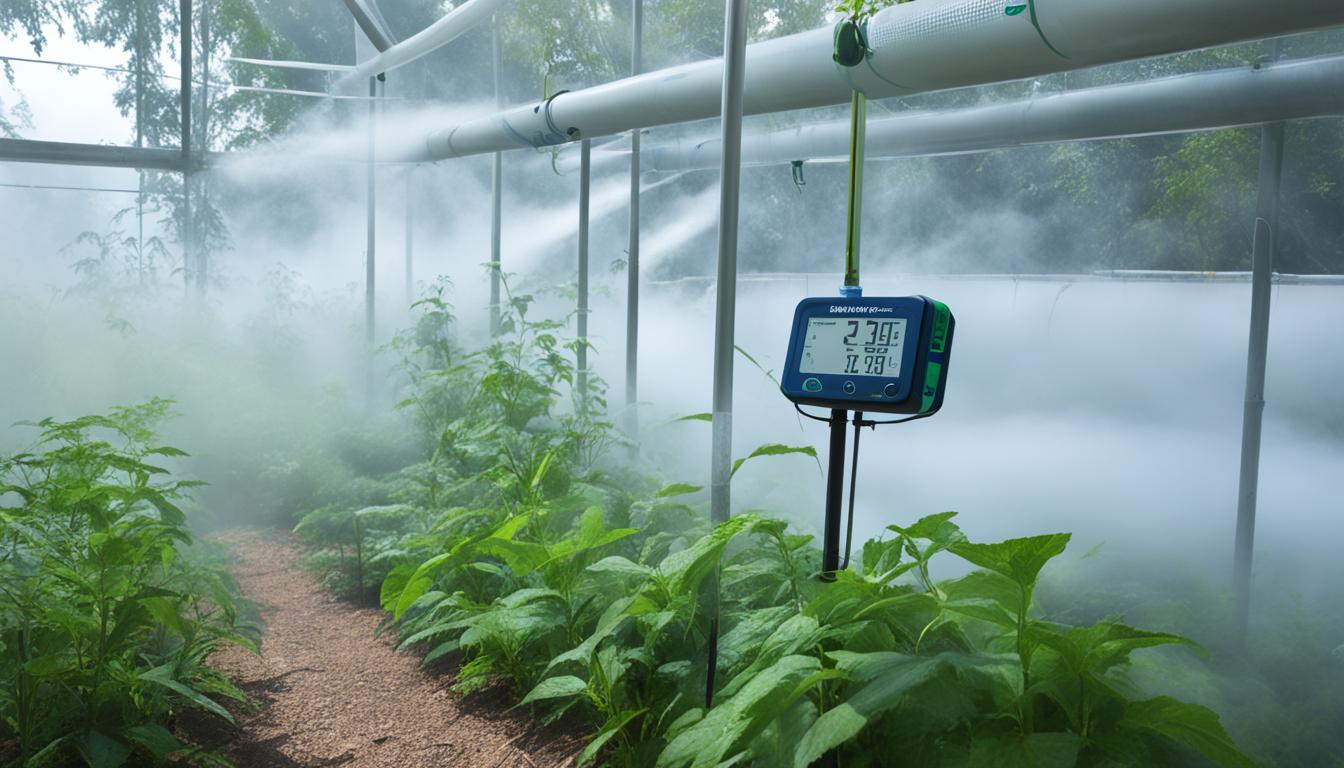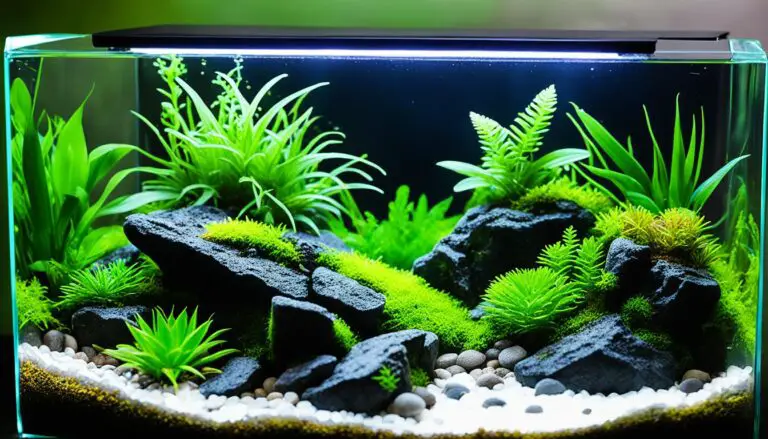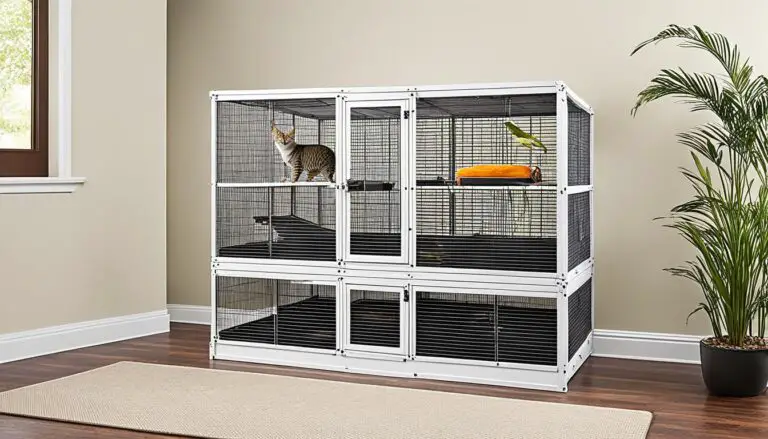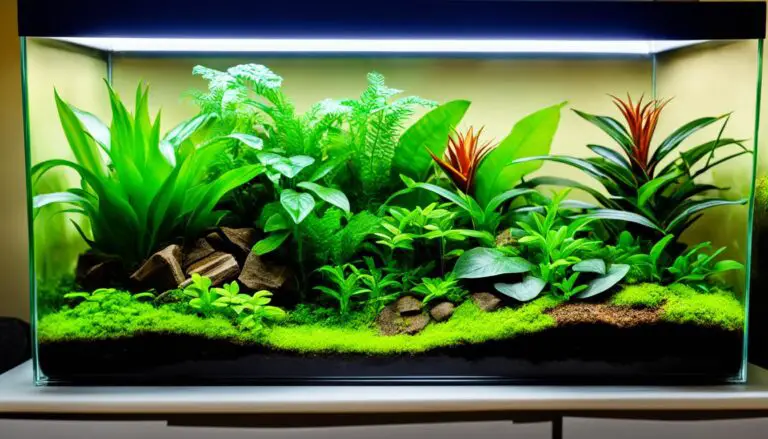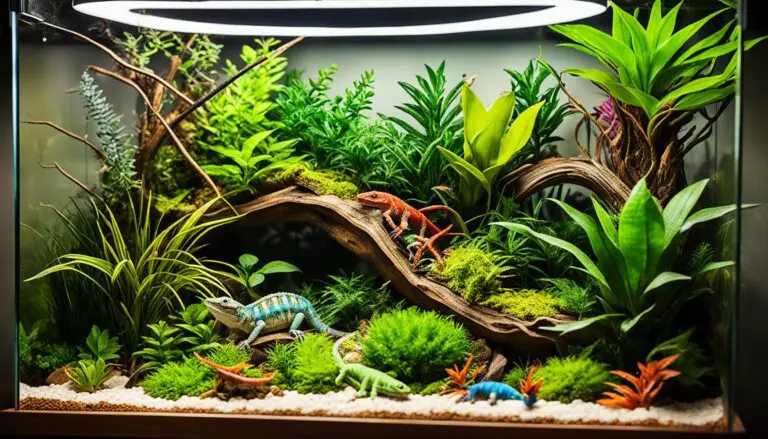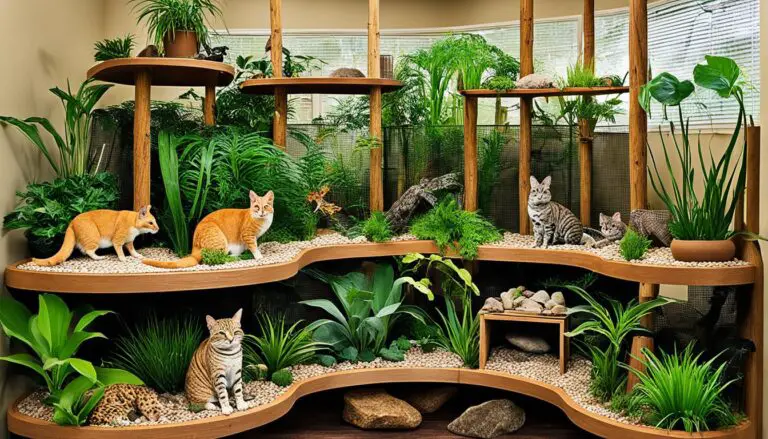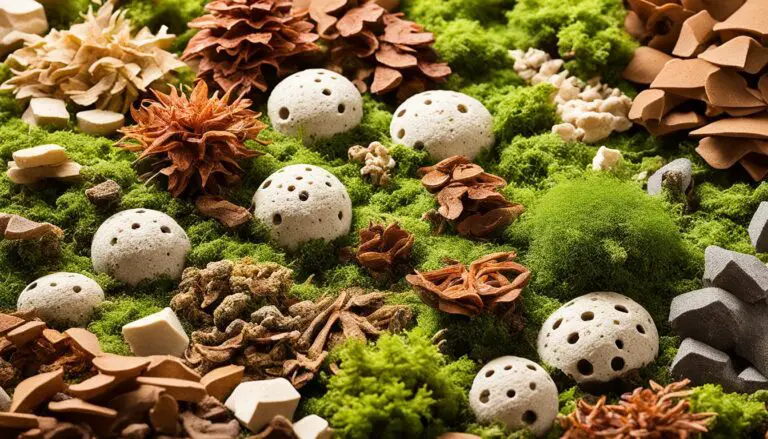Ideal Exotic Pet Housing Humidity – Quick Guide
Maintaining the ideal humidity in exotic pet enclosures is crucial for the health and comfort of reptiles and amphibians. Understanding humidity and its importance is vital for exotic pet keepers. While some species thrive in high humidity environments, others require lower levels. Researching the natural history and habitat of the species is key to determining the ideal humidity range for each pet. Humidity can be increased through various methods such as using a drainage layer in the substrate, live plants, pools of water, and regular misting. On the other hand, low humidity enclosures, particularly for desert species, require proper ventilation and infrequent spraying. It is important to maintain humidity levels that are suitable for the specific species to ensure their well-being.
Key Takeaways:
- Humidity is crucial for the health and comfort of exotic pets, particularly reptiles and amphibians.
- Researching the natural history and habitat of the species is important to determine their specific humidity requirements.
- Methods such as using a drainage layer, live plants, water pools, and misting can help regulate humidity levels.
- Proper ventilation is necessary for low humidity enclosures of desert species.
- Maintaining suitable humidity levels is essential for the overall well-being of exotic pets.
The importance of humidity for exotic pets
Proper humidity is vital for the well-being of all species, but tropical reptiles, amphibians, and invertebrates are particularly reliant on it. Researching the natural history of the species is crucial to understand their specific humidity requirements. Tropical species typically require high humidity, while desert species thrive in drier conditions. Humidity plays a critical role in respiratory function, hydration, and shedding for amphibians. It is important to create a suitable enclosure that mimics the natural habitat and provides the necessary humidity levels for the exotic pets to thrive.
Tips for humidity regulation in exotic pet habitats
Regulating humidity is essential for creating a suitable environment for your exotic pets. Here are some tips and best practices to ensure optimal humidity levels in their habitats:
- Use a drainage layer: Placing a drainage layer beneath the substrate can create a reservoir of water, gradually increasing humidity within the enclosure.
- Utilize live plants: Live plants play a crucial role in humidity regulation. They release moisture through respiration and photosynthesis, helping to maintain humidity levels naturally.
- Position water sources strategically: Placing pools of water or strategically positioning water dishes can contribute to humidity increase. The evaporation of water from these sources adds moisture to the air.
- Consider moving water features: Incorporating moving water, such as artificial waterfalls, can help increase humidity through evaporation. This can be particularly beneficial for species that thrive in humid environments.
- Ensure proper ventilation: Proper ventilation is crucial for maintaining a balance between fresh air intake and humidity retention. It helps prevent excessive moisture buildup and stale air within the enclosure.
- Monitor room humidity: In some cases, it may be necessary to increase the humidity or temperature of the entire room to maintain suitable humidity levels within the enclosure. Using a hygrometer can help monitor room humidity accurately.
- Consider automated misting systems: Automated misting systems can simplify humidity maintenance for high humidity enclosures by providing regular misting. These systems ensure consistent moisture without overwhelming the enclosure’s environment.
Monitoring humidity levels is essential, as different species have varying humidity requirements. Regularly measure humidity and make adjustments as needed to create a comfortable and healthy living space for your exotic pets.
The impact of temperature on humidity regulation
Temperature plays a significant role in humidity regulation within exotic pet habitats. Warmer air has the capacity to hold more water vapor, resulting in higher humidity levels. The ideal temperature range for exotic pets varies depending on the species. However, most species thrive at temperatures ranging from the high 60s to mid-80s Fahrenheit. Maintaining suitable temperatures is crucial for creating an optimal environment for humidity control.
When it comes to heating options, it is important to choose carefully to avoid creating hotspots and endangering the well-being of the pets. Space heaters, for example, can provide consistent warmth throughout the room and help regulate the overall temperature. However, it is essential to steer clear of heat mats, pads, rocks, or lamps, as they can create localized hotspots that may harm the pets.
Monitoring and controlling both temperature and humidity levels are vital for the overall health and well-being of exotic pets. In order to provide a comfortable and suitable environment, it’s important to regularly measure and adjust temperature and humidity levels as needed.

Proper Temperature Guidelines for Exotic Pets
Here is a general temperature guideline for some popular exotic pets:
| Species | Ideal Temperature Range (°F) |
|---|---|
| Bearded Dragon | 85-95 |
| Ball Python | 78-85 |
| Leopard Gecko | 80-88 |
| Crested Gecko | 72-80 |
| Red-Eared Slider Turtle | 75-85 |
These temperature ranges are meant as a general guideline and may vary depending on factors such as age, health, and species-specific requirements. It’s essential to research the specific temperature needs of your exotic pet to provide them with the most suitable habitat.
Humidity Control in Pet Habitats
Proper humidity regulation in pet habitats is crucial for the overall health and well-being of exotic pets. In order to maintain suitable humidity levels, it is important to consider temperature, ventilation, and the specific needs of each species. By ensuring the ideal temperature range and implementing effective humidity control methods, such as misting, using water dishes, and employing appropriate substrate, pet owners can create a comfortable and thriving environment for their exotic pets.
Challenges and considerations for humidity control
Ensuring the ideal humidity in exotic pet enclosures can be a challenging task, especially for keepers residing in extreme climates or homes with drafts. However, with proper consideration and the right tools, maintaining optimal humidity levels is achievable.
A reliable option for increasing humidity in dry or cold environments is using a humidifier. These devices add moisture to the air, creating a suitable environment for exotic pets. By choosing the right humidifier for your needs, you can effectively regulate the humidity levels in your pet’s enclosure.
Additionally, monitoring the humidity levels is essential to maintain the ideal range. Using a hygrometer allows you to measure and track the humidity levels accurately. This way, you can make timely adjustments to ensure the well-being of your pets.
When considering humidity control, it is important to take into account various factors, such as:
- Room temperature: The temperature of the room affects humidity levels. Ensure that the room temperature is suitable for your pet’s species to maintain optimal humidity levels.
- Ventilation: Proper ventilation is necessary to prevent excessive humidity buildup and provide fresh air circulation for your pets.
- Specific needs of the exotic pets: Different species have varying humidity requirements. Researching your pet’s specific needs will help you create the best possible environment for them.
By considering these factors and using the right tools, you can overcome the challenges associated with humidity control and provide your exotic pets with a comfortable and healthy habitat.
| Humidity Control Considerations | Benefits |
|---|---|
| Using a humidifier | Increases humidity in dry or cold environments |
| Monitoring humidity with a hygrometer | Ensures humidity remains within the appropriate range |
| Taking room temperature into account | Maintains optimal humidity levels |
| Proper ventilation | Prevents excessive humidity buildup |
| Considering the specific needs of the exotic pets | Creates the best environment for their well-being |
The Importance of Humidity Control
“Maintaining optimal humidity levels is crucial for the health and comfort of exotic pets. By overcoming the challenges associated with humidity control, you can provide your pets with a habitat that mirrors their natural environment and ensures their well-being.” – Dr. Samantha Parker, Exotic Pet Specialist
Understanding and addressing the challenges of humidity control are essential for exotic pet keepers. By utilizing humidifiers, monitoring humidity levels, and considering the specific needs of the pets, you can create a suitable environment that promotes their health and happiness.
The role of burrows and microclimates in humidity regulation
Many tarantulas and other burrowing species create elaborate burrows that play a crucial role in maintaining humidity in exotic pet enclosures. These burrows act as microclimates within the enclosure, allowing the humidity to differ significantly from the surrounding environment.
Understanding the natural behaviors and habitat preferences of the exotic pets is essential in creating suitable microclimates within the enclosures. By mimicking their natural habitat, we can provide the optimal humidity levels necessary for their well-being.
One important factor in maintaining humidity within these burrows is the substrate. Using a deep and moist substrate helps retain moisture and promotes humidity. It is crucial to choose a substrate that holds moisture well and doesn’t dry out quickly.
Proper ventilation is another key consideration in humidity regulation. It is important to ensure that the enclosure has adequate airflow while maintaining the desired humidity levels within the burrows. This can be achieved by positioning ventilation holes strategically and using vents that allow for controlled air circulation.
To cater to the diverse needs of exotic pets, it is essential to provide a range of humidity options within the enclosure. This can include the use of humid hides, which are small enclosed areas that maintain higher humidity levels, or different substrate areas with varying humidity levels.
Creating microclimates within the enclosure helps replicate the natural environment of the exotic pets, offering them a comfortable and suitable habitat. By providing a range of humidity options, we ensure that the pets have the choice to seek the humidity levels that best meet their needs.

Conclusion
Maintaining the ideal humidity is crucial for the health and comfort of your exotic pets. Understanding the specific humidity requirements for reptiles, amphibians, and invertebrates is essential to provide them with a suitable environment. By utilizing various methods such as a drainage layer, live plants, water pools, and regular misting, you can effectively regulate humidity levels in their enclosures. Temperature and ventilation also play significant roles in humidity control.
Monitoring humidity levels regularly and making necessary adjustments ensures that your pets are living in an optimal environment. By achieving the proper humidity range, you can ensure their well-being and support their natural behaviors and physiological processes. Creating a comfortable and healthy habitat for your exotic pets is crucial for their overall health and happiness.
Remember to research the specific humidity requirements of your pet’s species, mimic their natural habitat as closely as possible, and provide consistent and appropriate humidity levels. By doing so, you can create a thriving environment for your exotic pets, promoting their overall vitality and longevity. Maintain proper humidity levels in your pet enclosures, and your beloved companions will thrive under your care.
FAQ
Why is maintaining the ideal humidity important in exotic pet enclosures?
How can I regulate humidity in my exotic pet’s habitat?
What is the impact of temperature on humidity regulation?
What are some challenges and considerations for humidity control?
What is the role of burrows and microclimates in humidity regulation?
What is the importance of maintaining the ideal humidity in exotic pet enclosures?
Source Links
- https://www.sensorpush.com/articles/temperature-and-humidity-monitoring-for-pet-reptiles-and-amphibians
- https://tomsbigspiders.com/2015/01/19/humidity-temperature-and-tarantulas/
- https://exoticskeeper.com/blog/the-ek-guide-to-humidity
Peter Stones is the founder of Exotic Pets Place, the leading online resource for exotic pet care information.
With over 10 years of hands-on exotic pet ownership experience, he is deeply passionate about sharing his expertise to help others properly care for their unusual pets.
When he's not writing extensively researched articles or connecting with fellow exotic pet enthusiasts worldwide, you can find Peter at home tending to his own beloved menagerie of exotic animals.

